Exploring December's Birthstones: Turquoise and Zircon


Intro
December's chill doesn't just bring snow; it also brings two captivating gemstones that have enchanted people for centuries—turquoise and zircon. These stones hold not only unique beauty but also significant historical and cultural meanings. For those born in December, these birthstones offer a blend of aesthetics and lore. Whether you're an enthusiast, a collector, or a jewelry designer, understanding the essence of these stones can deepen your appreciation and guide your choices.
In this exploration, let’s uncover the richness of turquoise and zircon. From their definitions and origins to their physical properties and metaphysical claims, every facet contributes toward their charm. The following sections will delve into historical narratives, care tips, and practical advice to enhance your connection to these exquisite gemstones.
Gemstone Overview
Definition and Origins
Turquoise, a striking blue to green mineral, is primarily composed of copper and aluminum with water. It has been revered since ancient times, often found in jewelry and artifacts, valued for its vibrant color and perceived protective qualities. The name itself comes from the French word "turques," meaning Turkish, as the stone was initially brought to Europe from Turkey. The early Egyptians adorned themselves with these stones, believing they held powers of protection, luck, and health.
On the other hand, zircon is often mistaken for diamond due to its brilliance and clarity. Zircon is a naturally occurring mineral that is made up of zirconium silicate. Its colors can vary widely, from colorless to blue, red, or yellow. Historically, zircon has been used in various cultures not only for adornment but also as a talisman believed to ward off evil spirits. The word "zircon" is derived from the Persian word "zargun," meaning golden-colored, reflecting one of its many hues.
Historical Significance
Throughout the ages, these gemstones have been woven into the fabric of various cultures. For instance, turquoise has played an integral role in Native American traditions, symbolizing nature, protection, and healing. It's often found in artworks, decorations, and sacred objects.
Conversely, zircon’s historical significance spans much wider, appearing in royal artifacts and ancient jewelry. Its refractive qualities caught the eyes of many, establishing its popularity in gemstones. This mineral was notably used in the brilliant crowns and necklaces of monarchs.
Did you know? Turquoise was famously cherished by Cleopatra, who wore it as a talisman for power and protection.
Both stones may come from different backgrounds, but together, they embody a rich tapestry of tradition and beauty, attracting admirers even in contemporary times.
Gemstone Properties
Hardness and Durability
When considering stones for jewelry or collectors' items, hardness and durability are paramount. Turquoise scores between 5 to 6 on the Mohs scale, making it relatively softer than many other gemstones. This translates to a need for careful handling to prevent scratches or damage. Its porous nature means it can absorb oils and dirt, making regular cleaning essential.
In comparison, zircon boasts a higher score, typically around 6 to 7.5 on the Mohs scale, thus offering better resilience. This durability makes it a favored choice for rings and frequently worn pieces. However, like any gemstone, care is still advised to maintain its shine and prevent wear.
Color and Clarity
Both turquoise and zircon are celebrated for their spectacular color ranges. Turquoise is most appreciated for its vivid blues, often interspersed with green and black veins, creating unique patterns that appeal to many. Meanwhile, zircon is cherished for its color variety, ranging from deep blue to yellow and even red. Clear zircon, which can mimic diamond, remains a choice for high-end jewelry due to its brilliant sparkle.
While both stones vary in clarity, turquoises are usually more opaque, showcasing their unique earthy appeal. Zircon, on the other hand, often exhibits a higher degree of clarity, enhancing its glamorous look. The characteristics of both create contrasting but equally compelling options for those drawn to December’s birthstones.
Preface to December Birthstones
The topic of December birthstones carries a unique significance within gemstone culture, connecting individuals to deeper meanings and histories. This section serves as a foundation, establishing the importance of the stones associated with December, namely turquoise and zircon. Each gemstone is not just an accessory but embodies personal stories, beliefs, and cultural heritage.
Overview of Birthstones
Gemstones have a longstanding history intertwined with mythology and tradition. Birthstones act as symbols, representing the specific month of an individual's birth. They are often believed to bring good fortune and protection to the wearer. Traditionally, each month has its own gem, with December showcasing turquoise and zircon, both rich in color and meaning.
- Turquoise is admired for its vibrant blue to greenish hues, often found in Native American jewelry, reflecting the earth and sky.
- Zircon, on the other hand, can range in color from clear to blue, green, and yellow, and is celebrated for its brilliance and fire, often mistaken for diamond.
Understanding the connection of these gemstones to one’s birth month can add a layer of personal significance, making them more than mere decorative items. When gifted or worn, these stones can energize personal identity and serve as reminders of various virtues like resilience and wisdom.
The Significance of December Stones
The stones of December, turquoise and zircon, are not just aesthetically pleasing; they carry profound cultural and metaphysical significance. Turquoise has been revered for centuries, seen historically as a protective stone that invites peace, while zircon often embodies purity and safety. Each stone holds unique attributes that reflect the traits often associated with those born in December, such as adaptability and creativity.
In various cultures, both gemstones are seen as tokens of strength. For instance:
- In Native American cultures, turquoise signifies protection against negative energies, often used in rituals.
- In ancient times, zircon was believed to possess healing properties and enhance one’s inner wisdom.
As we delve deeper into the unique qualities and importance of turquoise and zircon throughout this article, readers will gain insight into how these stones can not only enhance one’s jewelry collection but also enrich personal life through their historical context and metaphysical properties.
Turquoise: The Primary December Birthstone
Turquoise holds a special place as the primary birthstone for December. Its striking blue and green hues not only grab attention but resonate deeply across various cultures. As a stone traditionally associated with peace and protection, turquoise's significance extends beyond mere aesthetics, providing insights into emotional well-being and spirituality.
Characteristics of Turquoise
Color Variations
The color of turquoise can range from sky blue to a more greenish hue. This diversity is primarily attributed to the presence of copper and iron in the stone's composition. Understanding these variations is crucial for gemstone enthusiasts; the richer the blue, the more valuable the stone usually is. A vibrant sky blue turquoise, for instance, is a highly sought-after variety and can command significantly higher market prices than those with green undertones. The unique colors have made turquoise an enduring favorite in both traditional and contemporary designs, lending a sense of uniqueness and personal touch to jewelry pieces.
Physical Properties
Turquoise typically boasts a hardness on the Mohs scale of around 5 to 6, which makes it relatively durable yet still prone to scratching. The stone is porous, meaning that it can absorb oils and dirt from skin contact, which can alter its appearance over time. This characteristic can be both an advantage and a disadvantage. While it allows for unique patterns and variations within the gemstone, it also necessitates careful handling and maintenance. As such, collectors should choose their turquoise pieces based on how they plan to wear them—daily jewelry may need to be selected differently from more occasional wear items.
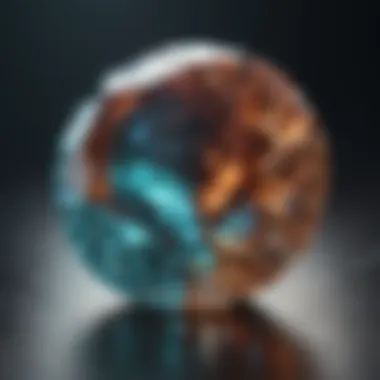
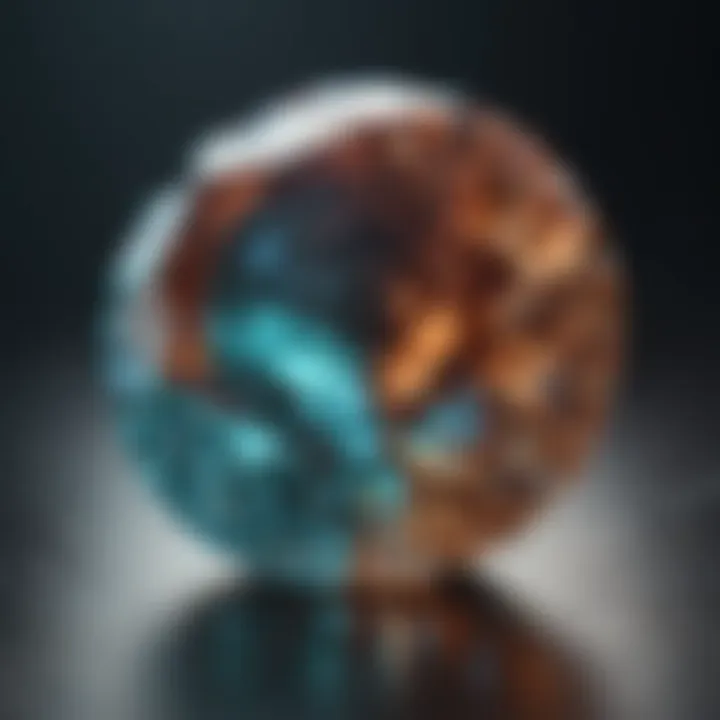
Common Sources
Most of the world’s turquoise supply comes from particularly rich mines in regions like Iran, China, and the southwestern United States. The notable presence of turquoise in these areas has historical roots that have long made it a beloved stone. The availability of turquoise continues to make it a desirable gemstone for collectors and designers alike. Some sources, particularly those in the U.S. like the Sleeping Beauty mine, are famed for their exceptional quality, often further driving demand. However, the market has also seen a rise in synthetic alternatives which mimic natural turquoise, providing consumers with more options—though not all hold the same intrinsic value.
Cultural Significance of Turquoise
Historical Context
Turquoise has been revered for thousands of years. Ancient civilizations such as the Egyptians and Native Americans saw it as a stone of power and healing. Artifacts and jewelry pieces made from turquoise have been found in burial sites, serving as protective talismans. Its long legacy positions it as a cultural bridge connecting the past and the present.
Symbolism Across Cultures
Across different cultures, this gemstone is often seen as a symbol of protection and tranquility. For Native American tribes, it represents the sky and water, signifying balance and harmony. In contrast, in ancient Persian culture, it was thought to help identify truth and intuition. The cultural resonance of turquoise is significant, as it speaks to the shared human experience of seeking peace, wellness, and protection.
Contemporary Relevance
In the modern world, turquoise remains a staple in fashion and wellness. Designers fuse traditional motifs with new styles, while many wellness advocates regard the stone as a powerful tool for emotional stability. Jewelry created with turquoise not only carries aesthetic appeal but also embodies a sense of spiritual connection, providing wearers with a sense of grounding in today’s fast-paced world.
Metaphysical Properties of Turquoise
Healing Attributes
Turquoise is not just for adornment; it's believed to possess potent healing properties. Many practitioners in alternative medicine advocate for turquoise's ability to dispel negative energy and promote peace. Regular exposure to this stone is thought to alleviate anxiety and invite calmness into one’s life. For this reason, enthusiasts often incorporate turquoise in meditation practices.
Spiritual Journeys
Many who practice spirituality see turquoise as a guide. It is thought to encourage self-discovery, encouraging individuals to find their true selves. This connection to the deeper self has made turquoise popular not just in jewelry but also in talismans and spiritual artifacts, integrating into various healing practices.
Chakra Associations
Believers in chakras often connect turquoise to the throat chakra, promoting communication, truth, and inner wisdom. By encouraging open dialogue and expression, turquoise supports connecting with one’s authentic voice—an attribute that's particularly dear in today's communication-driven society.
Turquoise in Jewelry
Design Trends
As trends continuously evolve, turquoise has unmistakably carved its niche. In recent collections, bold statement pieces combining turquoise with metals like gold or silver have gained popularity. Its distinctive coloration adds an appealing contrast that aligns well with contemporary aesthetics. Additionally, eco-friendly and ethically sourced pieces are making strides in the current jewelry landscape, appealing to conscientious buyers.
Selecting Quality Turquoise
Choosing high-quality turquoise involves examining several factors: color saturation, matrix pattern, and overall integrity of the stone. Authentic, well-preserved turquoise will have a rich color, minimal pits, and no synthetic feeling. Buyers should approach each piece with an informed mindset, recognizing the significance of provenance and treatment in determining both quality and value.
Care and Maintenance
Proper care can prolong the life of turquoise jewelry. Regular cleaning with gentle soap and water will prevent dirt build-up. It's advisable to keep turquoise away from chemicals, heat, and bright sunlight to maintain its vibrant appearance. Understanding these maintenance practices will ensure that both collectors and casual wearers can enjoy their turquoise for years.
"A genuine, well-cared-for piece of turquoise not only adds beauty to its wearer but also pays homage to the rich history woven into its very essence."
Overall, turquoise captures both the imagination and spiritual desires of those who wear it. As December's primary birthstone, its layers of significance and beauty offer something for everyone.
Zircon: The Alternative December Birthstone
When considering December’s birthstones, zircon often plays second fiddle to the more renowned turquoise. Yet, zircon holds a significant place in the gemstone hierarchy due to its beauty, versatility, and rich history. This section dives into various facets of zircon that make it a noteworthy alternative for those born in December or anyone captivated by the allure of gemstones.
Understanding Zircon
Appearance and Clarity
Zircon is prized for its brilliant appearance, resembling diamonds in clarity and fire. Its sparkling qualities stem from its high refractive index, which means it reflects light beautifully. The range of colors found in zircon, from sky blue to vibrant yellow and earthy red, adds depth to its appeal.
One of the most beloved characteristics of zircon is its versatility. Unlike some gemstones that appear dull in certain settings, zircon remains radiant in a variety of jewelry styles, effortlessly enhancing modern and vintage pieces alike. However, its clarity can vary significantly. While some zircons exhibit flawless transparency, others may contain surface blemishes that can affect their overall beauty—therein lies a balance that requires careful selection.
Physical Attributes
Zircon isn’t just a pretty face; it boasts solid physical attributes, including a Mohs hardness of 6 to 7.5, which makes it relatively durable yet requires some care when worn in daily accessories. Its density gives it a satisfying weight, making zircon feels more substantial than some lighter gemstones.
Particularly alluring is the gemstone’s ability to achieve excellent brilliance due to its double refraction – what this means is, when light passes through zircon, it splits, creating an extraordinary shimmering effect. However, this feature may also serve as a point of caution; collectors must ensure that they select high-quality pieces that can withstand daily wear without losing their luster.
Location of Deposits
Zircon deposits can be found in numerous locations around the globe, including Australia, Cambodia, and the United States. Australia stands out due to its large production of zircon, providing some of the finest and most sought-after stones.
The geographical spread contributes to varying qualities and colors offered within the gemstone market. However, sourcing can sometimes lead to a challenge; while some regions produce a wealth of zircon, higher quality stones may be rarer, impacting the buyer’s choices. Understanding these origins allows enthusiasts and collectors to make informed decisions when purchasing zircon, maintaining an eye on authenticity and ethical sourcing.
Cultural and Historical Insights
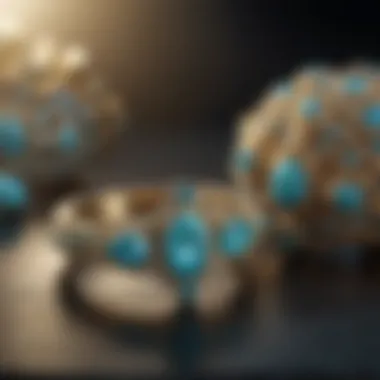
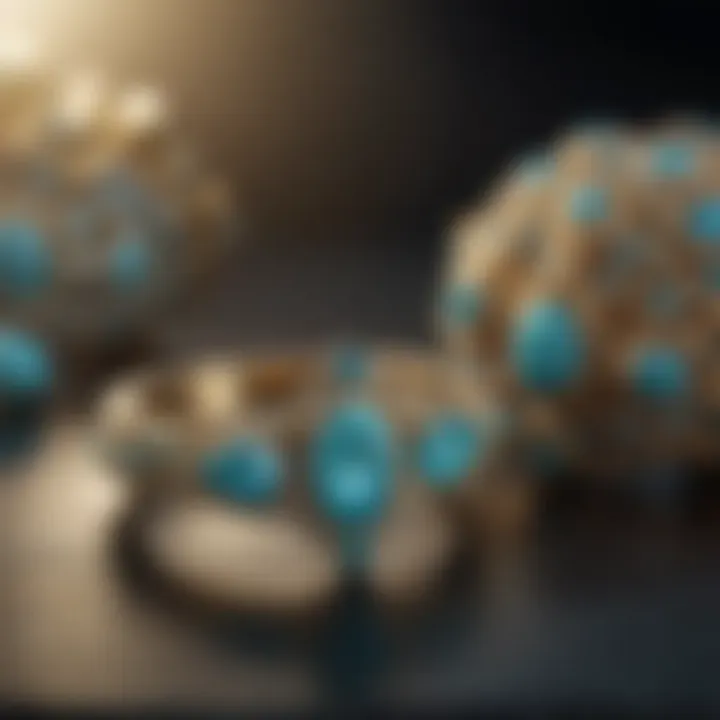
Ancient Beliefs
Zircon has been known since antiquity and has held various meanings across different cultures. Ancient Egyptians used it for protection, believing it could provide safety in the afterlife. In the Middle Ages, it was considered a protective stone against evil spirits. This rich historical resonance adds a unique layer to the gemstone, making it cherished across generations.
The belief that zircon can promote tranquility and foster deep connections still resonates among modern users, illustrating its timeless reputation as a talisman of sorts.
Historical Uses
Historically, zircon has made its mark not just as jewelry but in various ornamental applications; it was often ground into a powder for use in fine artists' colors in the Renaissance period. Artistic applications further emphasize its versatility beyond mere adornment, showcasing the creative potential locked within the stone.
In this regard, zircon serves as proof of how a single stone can traverse cultural boundaries and eras, living through different facets of human creativity and emotion.
Modern-Day Applications
Today, zircon is widely appreciated in both fine jewelry and fashion trends, recognized not only for its unique characteristics but also for its ethical implications when sourced responsibly. Jewelers often promote zircon as a substitute for diamond, offering a beautiful alternative without the high price tag.
As environmental awareness grows, so does the popularity of ethically sourced zircon—an appealing option for conscientious consumers. This modern adaptation illustrates not only how zircon fits contemporary aesthetics but also its role in sustainable jewelry trends.
Metaphysical Qualities of Zircon
Healing Properties
Believers in the healing properties of stones assert that zircon can be beneficial for those facing challenges in personal and professional realms. The gemstone is said to promote mental clarity and emotional balance, allowing individuals to manage stress effectively.
Such qualities enhance its value to healthcare practitioners who may recommend it as an adjunct to more conventional healing practices.
Enhancement of Intuition
Zircon is also linked to the enhancement of intuition. It is thought to stimulate the mind, leading to heightened awareness and improved decision-making processes. This feature can especially appeal to those in creative and decision-driven fields, making it a popular choice for professionals seeking clarity amidst chaos.
Chakra Connections
Believers often connect zircon to the root and crown chakras, associated with grounding energy and spiritual elevation, respectively. Its influence spans both ends of the spectrum, promoting a sense of stability while uplifting one's consciousness. Understanding these chakra connections may resonate deeply with gemstone practitioners and enthusiasts alike, providing both comfort and spiritual guidance.
Zircon in Fashion
Setting Trends
In the fashion world, zircon has been carving out its niche. Designers employ zircon in unique ways, combining it with metals ranging from platinum to gold, creating stunning contrasts that capture attention. The gemstone's array of colors enables it to be incorporated into seasonal fashion lines, ensuring its place in editorial as well as everyday wear.
In this context, zircon provides an exciting opportunity for creativity, challenging traditional concepts of beauty.
Evaluating Authenticity
As with any precious stone, authenticity plays a crucial role in the purchasing process. Examining a zircon's origin, clarity, and cut can help consumers assure their investment is genuine. Industry professionals highlight the need for certificates of authenticity when acquiring high-value pieces, enabling buyers to feel confident in their selections and investments.
Care Practices
Lastly, caring for zircon involves basic precautions to ensure longevity. Regular gentle cleaning and avoiding exposure to high-temperature situations are a few practices that can help keep zircon jewelry looking its best. Understanding the care practices necessary to maintain the stone can prolong its life and preserve its captivating beauty.
With this deep dive into the world of zircon, it emerges not only as an alternative birthstone but as a strong contender in the realm of gemstones, offering both beauty and significance that appeals to a wide audience.
"Zircon—more than just a gem; it tells stories of the past while dazzling in the present."
Comparison of Turquoise and Zircon
When we delve into the world of December birthstones, comparing turquoise and zircon unveils a wealth of concepts worth discussing. Both gemstones have their unique flair and attributes, catering to distinct preferences. In this section, we focus on several important aspects: visual distinctions, rarity, availability, and market trends.
Visual Distinctions
At a glance, turquoise and zircon might seem like two peas in a pod, but take a closer look, and the differences come alive. Turquoise is a robin's egg blue or greenish stone, often with a cloudy texture, exhibiting a naturally opaque finish. This charm lies in its irregular patterns and veining, which tell the story of its geological journey.
On the flip side, zircon dazzles with its translucent clarity. With its diverse color palette, ranging from blue to brown and even colorless variations, zircon can mimic the sparkle of diamonds without breaking the bank. Its cutting brilliance can make it hard to resist, particularly for those drawn to a more elegant aesthetic.
"Choosing between turquoise and zircon isn't about which is better; it’s about which speaks to you. Each stone carries a story, a personality."
Rarity and Availability
When it comes to rarity, turquoise is generally more abundant, though the quality can greatly vary depending on the source. High-quality turquoise is like finding a needle in a haystack, particularly shades that are vibrant and free of matrix. As a result, these premium specimens can command a higher price.
Zircon, a bit more elusive in specific colors, presents a different rarity dynamic. While common in its brown and clear forms, the deep blue zircon is a true treasure, seldom seen in the market or in jewelry. This can create spikes in demand when someone finally uncovers a stash of high-quality blue zircon, leading to fluctuating prices owing to its scarcity.
Market Trends
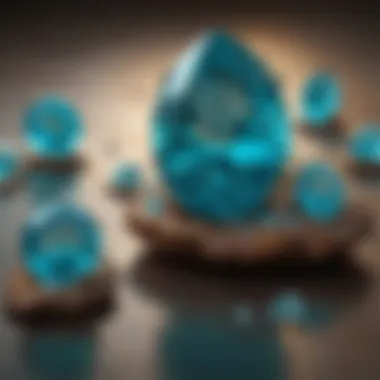
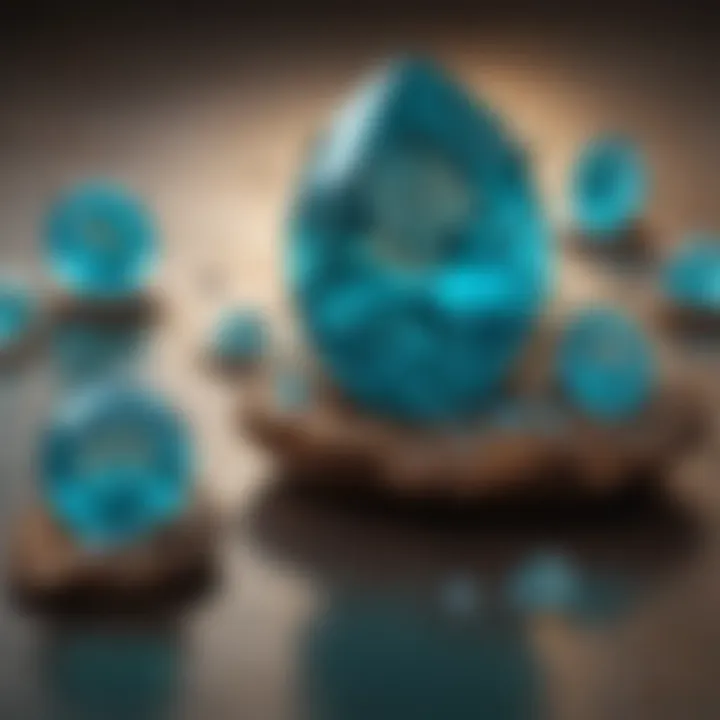
Market trends for turquoise and zircon reflect their cultural significance and consumer preferences. Turquoise has stood the test of time, consistently found in southwestern jewelry designs, symbolizing protection and healing. Its enduring popularity illustrates its role not just as a gemstone, but as a piece of artistic heritage, often featured in bohemian styles.
Zircon, on the other hand, is gaining traction among modern consumers who seek alternative gemstones. Designers are beginning to favor zircon in engagement rings and everyday jewelry, partly due to its affordability and visual appeal. The rise in eco-conscious shopping also plays a vital role in this trend, as zircon is often seen as a sustainable choice, especially compared to mined diamonds.
Understanding these nuances between turquoise and zircon can help enthusiasts, collectors, and jewelry designers make informed decisions tailored to their tastes and values.
Selecting December Stones as Gifts
Choosing the right gift is an art, and when it involves December's birthstones, Turquoise and Zircon, the stakes get a bit higher. These gemstones are not just pretty pieces of jewelry; they carry deep meanings, symbolize individuality, and reflect personal stories. Understanding how to select December stones as gifts involves a thoughtful approach that combines knowledge of the gemstones' properties with an appreciation of the recipient’s character and preferences.
Understanding recipient preferences
Tuning into what the recipient likes is crucial. Some people are drawn to certain colors or styles while others might prefer something more traditional. Turquoise, with its vibrant blue hues and earthy tones, often appeals to those with an artistic flair or a love for nature. On the other hand, Zircon, known for its brilliant sparkle, tends to enchant those who appreciate luxury and refinement.
To pinpoint what resonates with your recipient:
- Note their style: Do they lean towards vintage looks, or are they all about modern chic?
- Observe their color palette: Are they often seen in cool tones or warm hues?
- Consider their lifestyle: Is this a person who enjoys active pursuits or one who relishes quiet evenings at home?
By paying attention to these details, you can make a more informed choice.
Pairing Stones with Birth Characteristics
December birthstones not only represent the month but also convey specific traits associated with individuals born in December. When pairing stones with birth characteristics, it allows for a more personalized touch to your gift.
- Turquoise is believed to symbolize communication, healing, and protection. Those born in December are often seen as truth-seekers, and gifting turquoise may resonate with their desire for honesty and transparency.
- Zircon, particularly in its blue form, signifies wisdom and wealth. Its dazzling appeal makes it perfect for December-born individuals with a love for elegance and knowledge.
In making your selection, think about how the qualities of each stone align with the recipient's personality. This thoughtfulness adds layers of meaning to your present, transforming it from a simple gift to a cherished token.
Presentation and Packaging Suggestions
The final touches on a gift can make all the difference. Presentation is key, especially when it comes to December stones which already have a beautiful luster. Here are some ideas to elevate the impact of your gift:
- Use elegant boxes: A well-crafted box not only protects the jewelry but enhances anticipation. Consider using a soft velvet-lined box for a touch of luxury.
- Include a card with meaning: Write a note explaining the significance of the stone, espousing the traits it represents. This personal connection deepens the appreciation of the gift.
- Consider the wrapping: Choose wrapping materials that match the stone’s aesthetics. For turquoise, earthy tones and textures work well, while for zircon, a sleek metallic wrap might elevate its brilliance.
As the adage goes, "All that glitters isn't gold," but a thoughtful presentation can transform even the simplest of gifts into treasured keepsakes.
Remember, a gift becomes more meaningful when it reflects your thoughtfulness and consideration for the recipient's tastes and preferences.
Caring for December Birthstones
Taking care of December's birthstones, turquoise and zircon, is not just a routine chore; it's a vital practice that can sustain their beauty and integrity for years to come. Whether you're a jeweler creating unique pieces, a collector curating your collection, or simply an enthusiast who cherishes these stones, understanding the care needed for each type is paramount. Taking that time to maintain these gems keeps them vibrant and enhances their value, ensuring they are always ready to dazzle.
Cleaning Techniques
Cleaning your turquoise and zircon requires a gentle touch. Here's how to go about it:
- Turquoise: Due to its porous nature, turquoise shouldn’t be submerged in water. Use a soft, damp cloth to wipe away dust and dirt gently. A solution made of warm water and mild soap can be used sparingly, but avoid strong chemicals that could damage its surface.
- Zircon: Zircon is more durable but still benefits from gentle cleaning. You can use a soft toothbrush dipped in soapy water to clean hard-to-reach places, followed by a rinse under lukewarm water. Avoid ultrasonic cleaners as the vibrations may cause internal stress.
In both cases, make sure to dry thoroughly to prevent moisture from being trapped.
Storage Guidelines
Proper storage is equally crucial, as it can greatly affect the long-term condition of your stones. Here are some recommendations:
- Separate Settings: Store each gemstone separately to avoid scratching. Using velvet or soft pouches can be beneficial. Keep them in a dry place to prevent humidity damage.
- Avoid Direct Sunlight: Prolonged exposure to sunlight might cause fading in turquoise, while zircon can become clouded. Storing in a cool, dark area helps maintain their clarity and hue.
- Use a Jewelry Box with Dividers: This keeps your collection organized and reduces the risk of damage from getting tangled or knocked around.
Common Mistakes to Avoid
Even seasoned collectors can fall into traps when it comes to caring for these stones. Here are some pitfalls to steer clear of:
- Neglecting Regular Cleaning: Leaving dirt or grime can cause your turqouise to lose its vibrancy over time. Make cleaning a routine task.
- Using Harsh Chemicals: Cleaning solutions or jewelry cleaners filled with harsh ingredients are the nemesis of both turquoise and zircon. Stick to mild soaps and natural methods.
- Ignoring Temperature Changes: Rapid shifts in temperature can lead to damaging stress fractures, especially in zircon. Be mindful of where you wear and store your jewelry.
Keeping your turquoise and zircon cared for is more than just maintenance; it's a way to honor the natural beauty and history of these gemstones.
Finale
In wrapping up our exploration of December's distinctive birthstones, turquoise and zircon, it becomes clear that these gemstones hold a treasure trove of significance beyond their aesthetic appeal. Understanding the properties, cultural significance, and care of both stones enriches not only the appreciation of their beauty but also the experience of owning and gifting them. For enthusiasts and collectors alike, recognizing the individual traits of turquoise and zircon can greatly enhance their connection to these stones.
When selecting a piece or considering a gift, knowing the unique attributes of both stones aids in making informed decisions. Turquoise's rich history of protection and healing resonates deeply with many, while zircon captivates with its brilliant clarity and wide range of hues. Additionally, taking proper care of these gemstones ensures that they retain their allure for years to come, providing both joy and value.
Amidst the shifting market trends, the enduring popularity of both turquoise and zircon underscores their relevance in today's jewelry fashion. Therefore, tapping into the knowledge shared in this article equips readers with essential insights — from metaphysical properties to practical care tips, enhancing their experience with these December birthstones. In essence, it's not just about the stones themselves; it's about the narratives and experiences they carry with them, enriching our lives in subtle yet profound ways.
Summary of Key Points
- Significance of Birthstones: Understanding the cultural and historical relevance of turquoise and zircon enhances their appreciation.
- Unique Properties: Turquoise and zircon each possess distinct characteristics making them suitable for various preferences and occasions.
- Metaphysical Attributes: Each stone offers potential benefits that many view as supportive in healing and spiritual practices.
- Care and Maintenance: Proper caring practices are crucial for maintaining the longevity and brilliance of these gems.
Final Thoughts on December Stones
The allure of turquoise and zircon lies not just in their appearance but also in the stories they tell. As birthstones for December, they hold a dual significance, reflecting both the unique qualities of individuals born in this month and the timeless beauty of nature’s offerings. Gemstone enthusiasts, collectors, and jewelry designers can find endless inspiration in these stones, whether for personal collection or as gifts that speak volumes.
In an age where authenticity often gets overshadowed by trends, turquoise and zircon stand as reminders of a richer narrative woven through history, culture, and human experience. So, whether you're drawn to the serene blues of turquoise or the brilliant spark of zircon, know that you are holding something truly exceptional. Each gem is an embodiment of tradition and personal significance, making them timeless choices for any collection.



